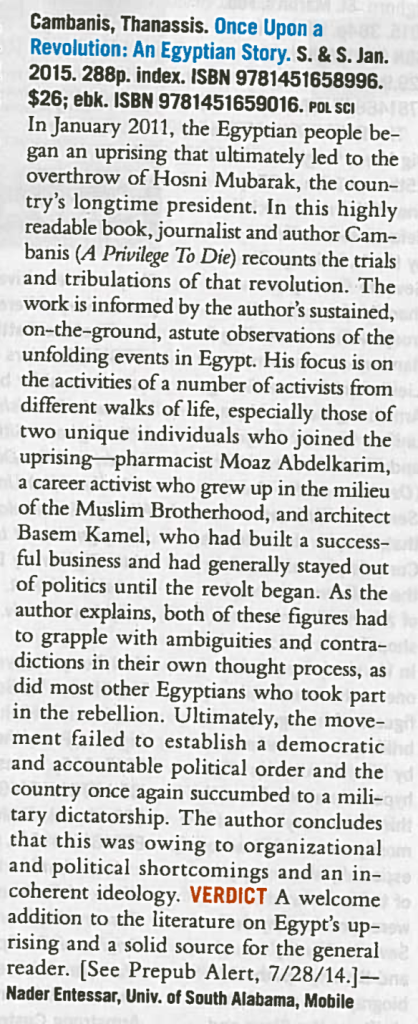Patrick Cockburn is a Middle East correspondent of The Independent of London. His latest book is “The Rise of Islamic State: Isis and the New Sunni Revolution.”
There was nothing culpable about this. Genuine revolutions may seem to succeed at first because they are the unexpected outcome of contradictory forces coming together almost by chance. When the first protest began in Cairo on the morning of Jan. 25, 2011, the demonstrators chanted: “Bread! Freedom! Social Justice! The people demand the fall of the regime.” Up to the last moment the organizers were uncertain that anybody would dare come out onto the streets to support them.
The most important revolution of the Arab Spring was in Egypt, whose 90 million inhabitants make it the most populous country in the Arab world. Had the revolutionaries won there, the balance of power between democracy and dictatorship would have changed across the region. Over 18 days, secular and Islamist opponents of President Hosni Mubarak fought together in and around Tahrir Square to end his 29 years in power. These were the heroic days of the revolution, and they were never to be repeated. Instead, divisions within the opposition became wider, while the partisans of the discredited old regime recovered their nerve and eventually returned to power. On July 3, 2013, a military coup with much popular support overthrew and jailed the first truly elected Egyptian president, Mohamed Morsi. In May 2014 the former army field marshal Abdel Fattah el-Sisi was elected president to replace him with 96.9 percent of the vote, a figure underlining the degree to which the authoritarian state was confidently back in business.
It is one of the many strengths of Thanassis Cambanis’s fluent, intelligent and highly informed book, “Once Upon a Revolution,” that he convincingly explains what happened in Egypt over the last four years. It should be read by anybody perplexed by how Egypt’s apparent entry into a brave new democratic world was ultimately defeated. This account has the vividness and readability of eyewitness reporting combined with an unsentimental and perceptive judgment about where the opponents of autocracy went wrong.
Cambanis, the author of “A Privilege to Die: Inside Hezbollah’s Legions and Their Endless War Against Israel,” got to know the activists who started the first demonstrations and describes developments as they appeared to him. He does not underestimate the difficulties the revolutionaries had in mobilizing people against a state that had developed so many instruments of control since the army first took power in Egypt in 1952. They had to overcome the sense of hopelessness and cynicism among the mass of Egyptians, who had come to believe that any attempt to better their lot was doomed to failure and might even leave them worse off. Egyptian leaders fostered this fear of insecurity, claiming that iron rule from the top was the only alternative to anarchy. “Egypt’s dictators had insisted that their subjects were incompetent, helpless sheep who needed a strong hand,” Cambanis writes. “Left on their own, they’d make a mess and starve to death.”
The supporters of democracy in Egypt always held a weaker hand than the outside world imagined. Mubarak fell because of pressure from below, but also because the Egyptian Army was alienated by his plan to have his son Gamal succeed him. The organizers of the street protests were naïve about taking advantage of their original astonishing successes; they never displaced their enemies from positions of power, attempting “a revolution without any of the usual political gambits. They didn’t try to take over the government’s television stations or any ministries.” Their restraint meant that they were slandered by the state media as well-off playboys and drug-takers, as sexually promiscuous or gay, and in the pay of foreign countries. The Western media exaggerated the extent to which the Internet, Facebook and YouTube circumvented government control of television, newspapers and radio. Cambanis concludes that “the Internet age hasn’t reconfigured the calculus of power.”
The weaknesses of the opposition were not all self-inflicted. It’s true that there was deep popular anger in Egypt because the ruling elite had never delivered prosperity in exchange for depriving Egyptians of their political and civil rights. Most people “found themselves in a Potemkin republic, crowded into unplanned apartments on narrow lanes, their grown children unemployable in Egypt whether they had a master’s degree or merely a strong back.” Poverty combined with miserable health and education facilities ensured plenty of dry tinder for revolutionaries. But the very backwardness of Egypt limited their ability to ignite it.
State propaganda for more than half a century had fostered delusions about military rule much to the advantage of those who benefited from the status quo. Demonstrators went on chanting “The army and the people are one hand” long after it was apparent that the army was orchestrating the murder, imprisonment and torture of protesters. Cambanis says that “even faced with overwhelming evidence of the military’s malfeasance, too many revolutionaries were willing to trust the military as an impartial referee. The revolution never sought to dispel the shibboleth that Egypt’s army was sacred.”
Somehow this army that never won a war in the 60 years it has ruled Egypt has avoided responsibility for the miserable state to which it has reduced the country. During the two years of revolutionary upsurge, it convinced Egyptians that it was the sole barrier against violence and sectarian hatreds that were fomented or manipulated by the military itself. When Copts demonstrated in front of Maspero, the state media headquarters in Cairo, they were shot down by soldiers and run over by armored cars. “Go help the army,” an announcer on state television declared. “Our soldiers are being attacked by Christians.”
Cambanis expresses uncertainty as to whether Tahrir Square was just an interlude in Egypt’s tragedy. He quotes Cairo street graffiti that ask, “Do you remember the tomorrow that never came?” His story of what happened will do much to keep that memory alive.



